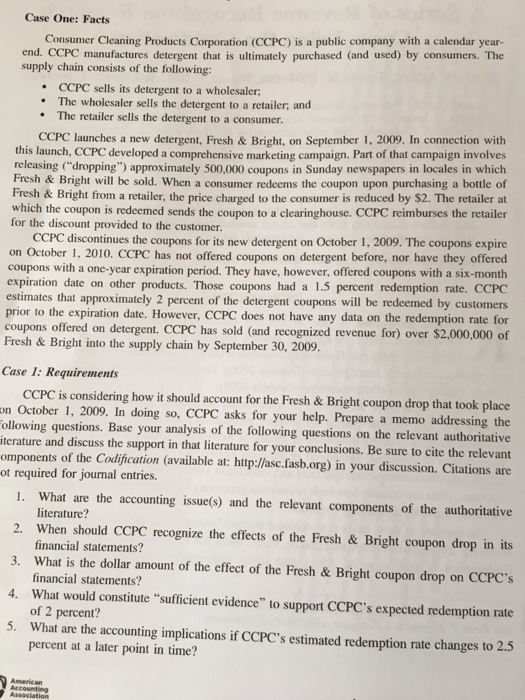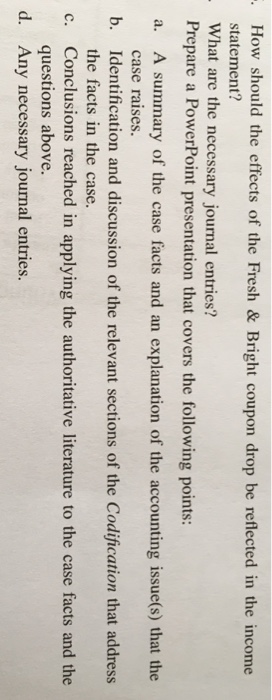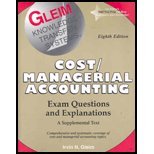Case One: Facts Consumer Cleaning Products Corporation (CCPC) is public company with a calendar year a end. CCPC manufactures detergent that is ultimately purchased (and used) by consumers. The supply chain consists of the following CCPC sells its detergent to a wholesaler The wholesaler sells the detergent to a retailer and The retailer sells the detergent to a consumer. CCPC launches a new detergent, Fresh & Bright, on September 1, 2009. In connection with this launch, CCPC developed a comprehensive marketing campaign. Part of that campaign involve releasing Cdropping") approximately 500,000 coupons in Sunday newspapers in locales which Fresh & Bright will be sold. When a consumer redeems the coupon upon purchasing a bottle of & Bright from a retailer, the charged to the consumer is by s2.The at which the coupon is redeemed sends the coupon to a clearinghou CCPC reimburses the retailer for the discount provided to the customer. discontinues the coupons for its new detergent on october 1, 2009. The coupons expire on October CCPC has not offered coupons on detergent before, nor have they offered coupons with a one-year expiration period. They have, however, offered coupons with a six-month expiration date on other products. Those coupons had a 1.5 percent redemption rate. estimates that approximately 2 percent of the detergent coupons will be redeemed by customers prior to the expiration date. However, coPC does not have any data on the redemption rate for coupons offered detergent. has (and revenue of Bright into the supply chain by September 30, 2009 Case 1: Requirements CCPC is considering how it should account for the Fresh & Bright coupon drop that took place october 1, 2009. In doing so, CCPC asks for your help. Prepare a memo addressing the ollowing questions. Base your analysis of the following questions on the relevant authoritative iterature and discuss the support in that literature for your conclusions. Be sure to cite the relevant omponents of the Codification (available at: http:/fasc.fasb.org) in your discussion. Citations are required for journal entrie l. What are the accounting issue(s and the relevant components of the authoritative literature? 2. When should CCPC recognize the effects of the Fresh & Bright coupon drop in its financial statements? 3. What is the dollar amount of the effect of the Fresh & Bright coupon drop on CCPC's financial statements? 4. What would constitute "sufficient evidence" to support CCPC's expected redemption rate percent What are the accounting implications if CCPC's estimated redemption rate changes to 2.5 percent at a later point in time? Case One: Facts Consumer Cleaning Products Corporation (CCPC) is public company with a calendar year a end. CCPC manufactures detergent that is ultimately purchased (and used) by consumers. The supply chain consists of the following CCPC sells its detergent to a wholesaler The wholesaler sells the detergent to a retailer and The retailer sells the detergent to a consumer. CCPC launches a new detergent, Fresh & Bright, on September 1, 2009. In connection with this launch, CCPC developed a comprehensive marketing campaign. Part of that campaign involve releasing Cdropping") approximately 500,000 coupons in Sunday newspapers in locales which Fresh & Bright will be sold. When a consumer redeems the coupon upon purchasing a bottle of & Bright from a retailer, the charged to the consumer is by s2.The at which the coupon is redeemed sends the coupon to a clearinghou CCPC reimburses the retailer for the discount provided to the customer. discontinues the coupons for its new detergent on october 1, 2009. The coupons expire on October CCPC has not offered coupons on detergent before, nor have they offered coupons with a one-year expiration period. They have, however, offered coupons with a six-month expiration date on other products. Those coupons had a 1.5 percent redemption rate. estimates that approximately 2 percent of the detergent coupons will be redeemed by customers prior to the expiration date. However, coPC does not have any data on the redemption rate for coupons offered detergent. has (and revenue of Bright into the supply chain by September 30, 2009 Case 1: Requirements CCPC is considering how it should account for the Fresh & Bright coupon drop that took place october 1, 2009. In doing so, CCPC asks for your help. Prepare a memo addressing the ollowing questions. Base your analysis of the following questions on the relevant authoritative iterature and discuss the support in that literature for your conclusions. Be sure to cite the relevant omponents of the Codification (available at: http:/fasc.fasb.org) in your discussion. Citations are required for journal entrie l. What are the accounting issue(s and the relevant components of the authoritative literature? 2. When should CCPC recognize the effects of the Fresh & Bright coupon drop in its financial statements? 3. What is the dollar amount of the effect of the Fresh & Bright coupon drop on CCPC's financial statements? 4. What would constitute "sufficient evidence" to support CCPC's expected redemption rate percent What are the accounting implications if CCPC's estimated redemption rate changes to 2.5 percent at a later point in time








